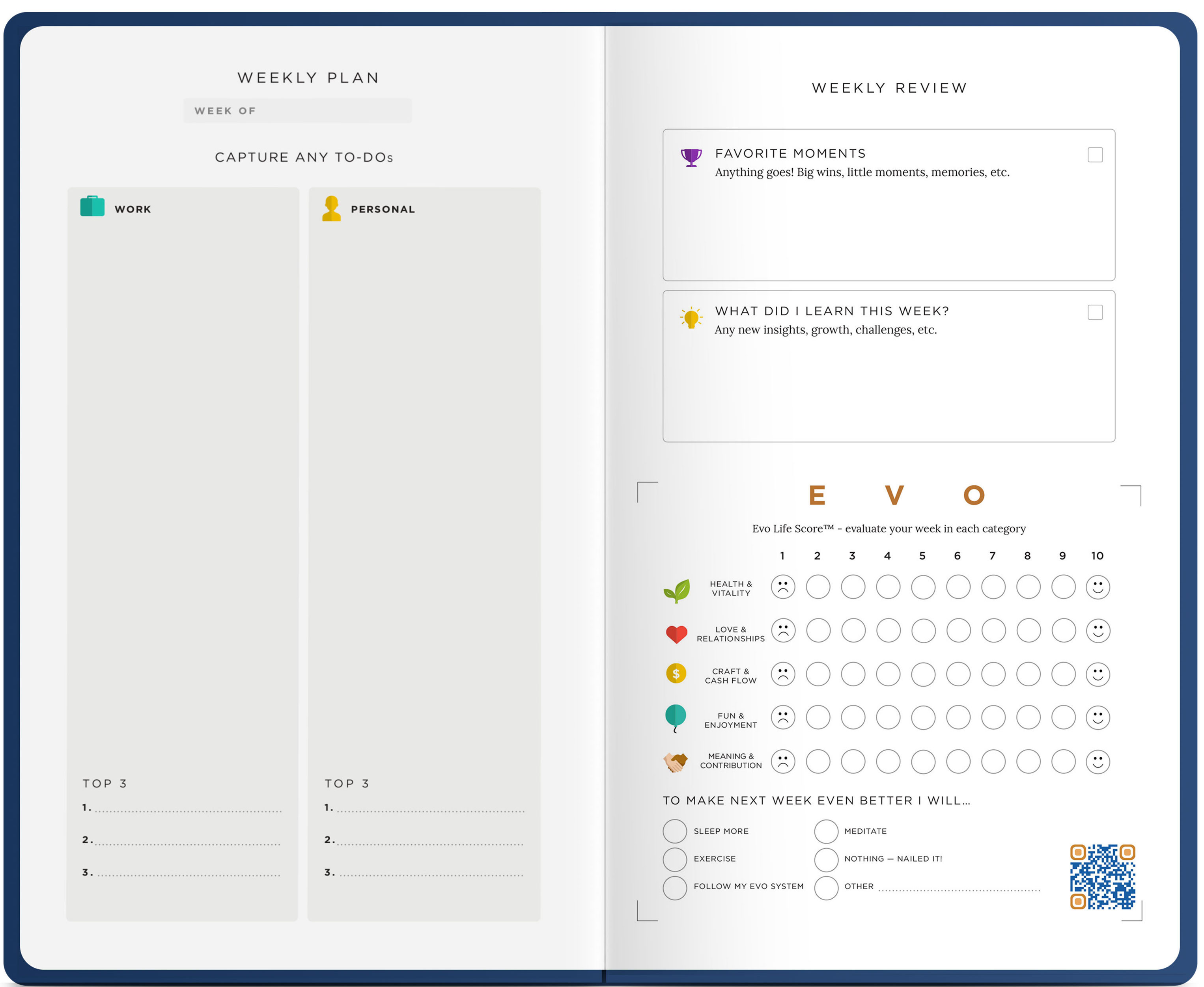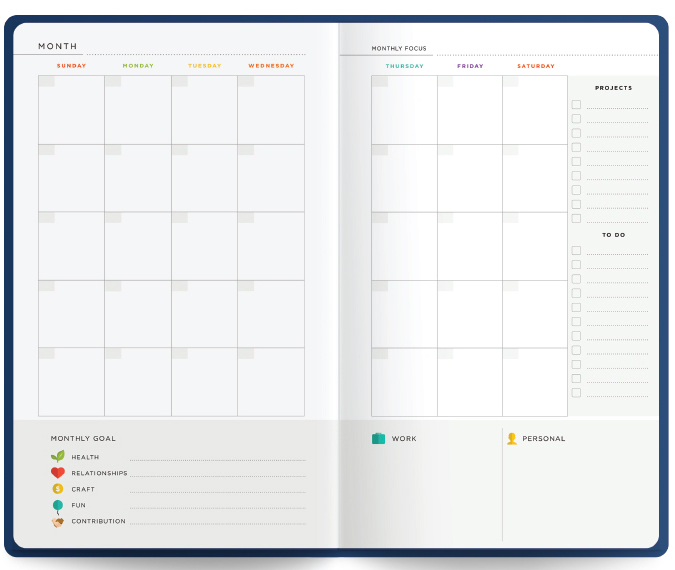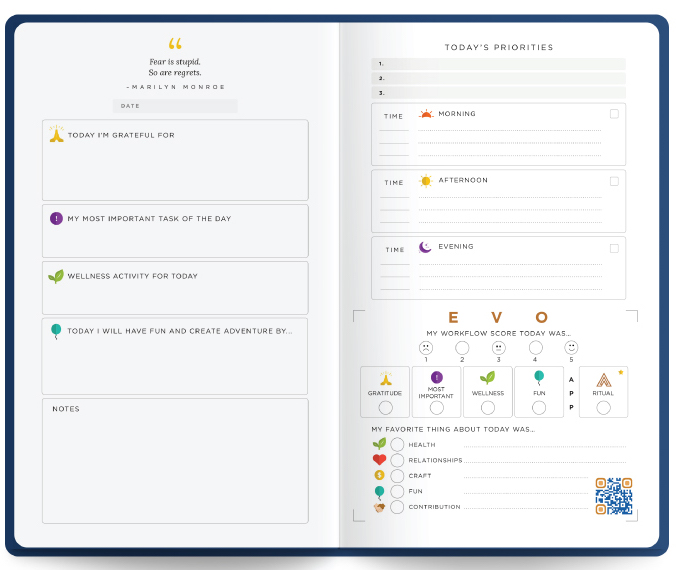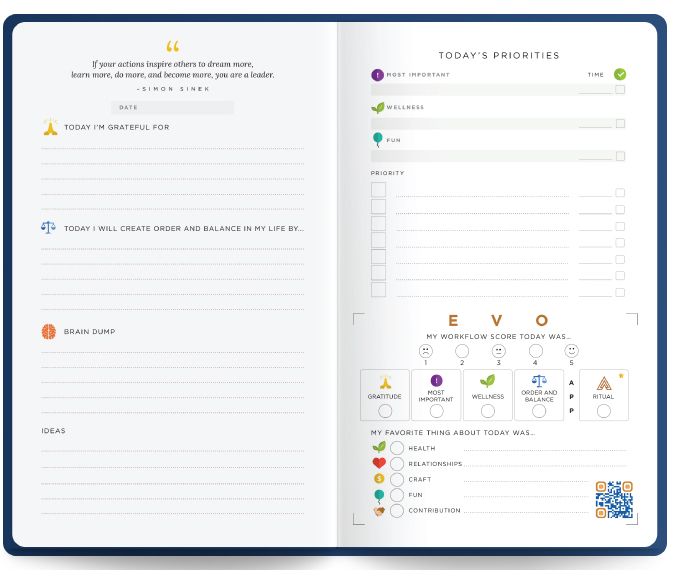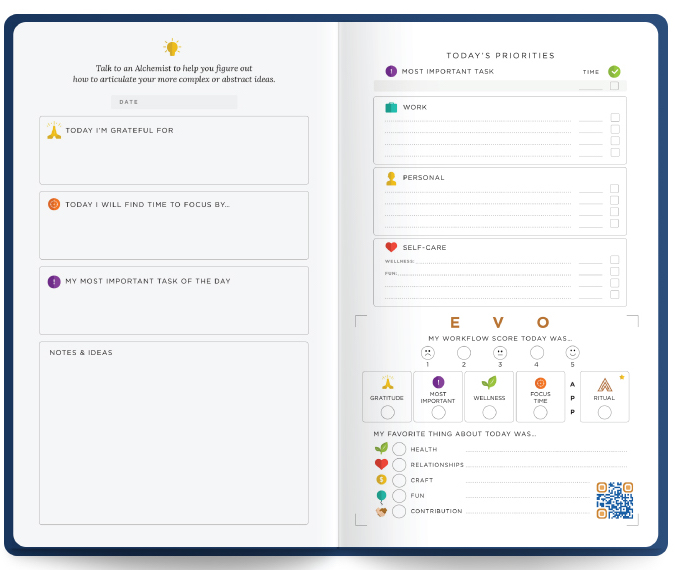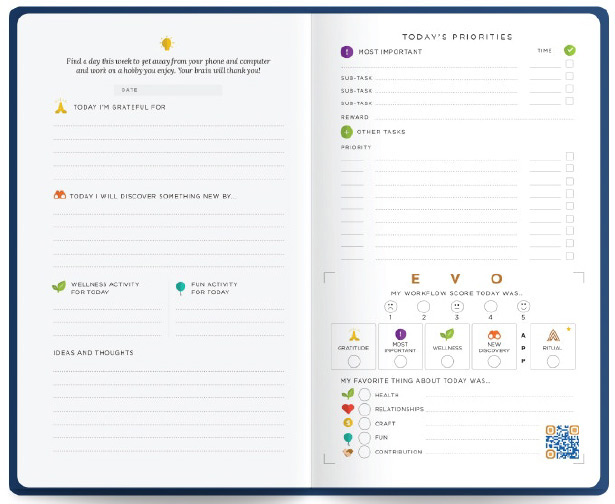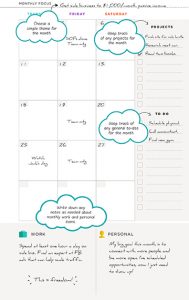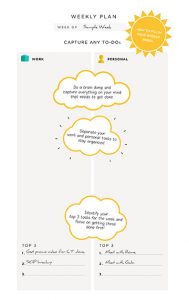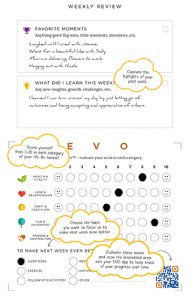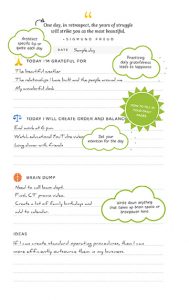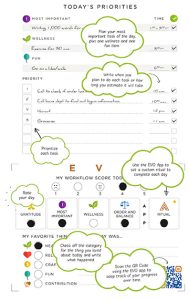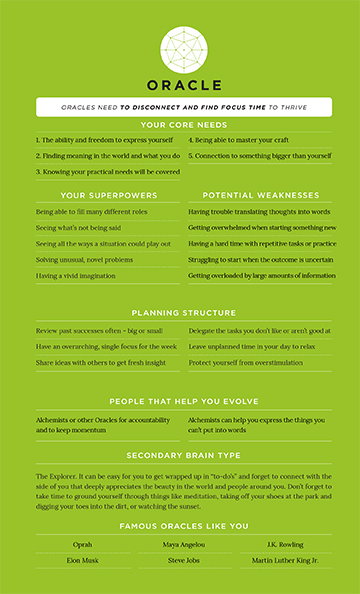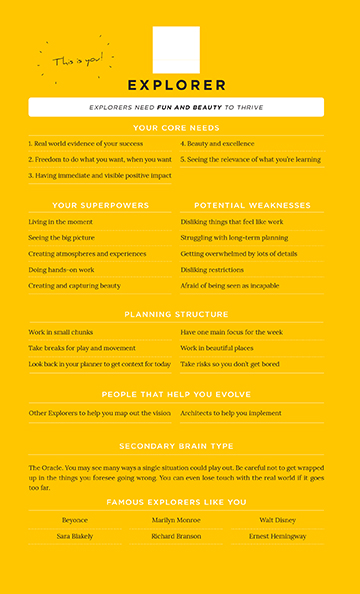BLOG
a
The Anatomy of Your EVO Type, Part IV: Putting It All Together To Create Your Unique EVO Type “Recipe”
by Iris Strauss
49769 views

This is part of a four-part series to help you understand why we present your EVO Elements Assessment results the way we do. Make sure you read all four parts in order to understand the structure of how your Elements fit together, and the reasoning behind that structure.
Read Part I here.
Read Part II here.
Read Part III here.
Make sure you’ve read Part I, Part II, and Part III of this series, as you will need the foundational understanding from those articles to fully appreciate and understand the information found here.
Here’s a reference in case you need to refer back to the basic descriptions of each Element and the foundational Balance Principle we have used to develop this system.
Feel free to skip these charts and head straight down to the *** below if you just read parts I, II, and III of this series.
- Everyone uses every kind of process—or, everyone is a little bit of everything. Meaning, every person has to have each type of Compass (logically-oriented, and gut instinct-oriented), each type of Brain Type (concrete-focused, and abstract-focused), and everyone has to have a preference for how they interact with others and the external world, as well as how they personally think, feel, and perceive their internal world.
- Balance. EVO Elements and their relationship to each other always represent balance in each aspect of the categories described above—abstract/concrete, logic/gut instinct, internal/external.
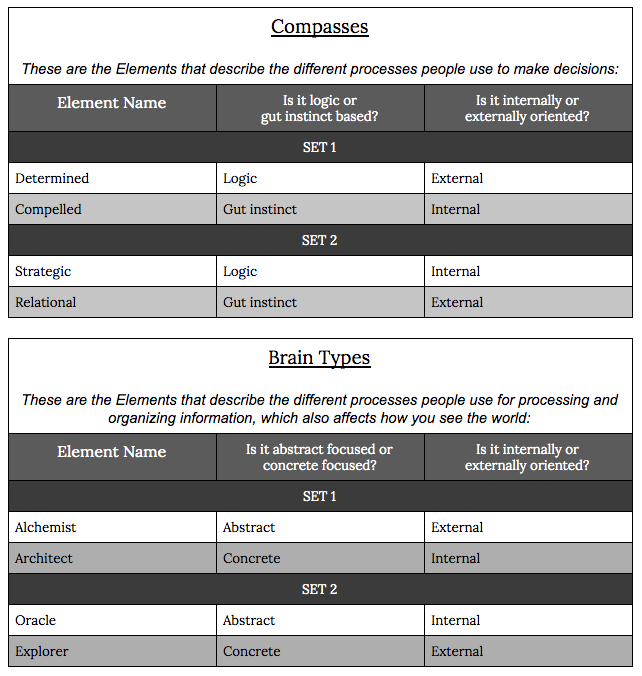
***
As we discussed in Part I of this series (Understanding Your Top Two Elements), the way we present your Elements in your EVO Element Assessment results has a very specific reason, which is described in the Balance Principle above, and can be summarized simply as: we need balance in all aspects of our mental processing.
The order of your Elements represents the way you operate when you are at your peak—when you’re doing the things you want to be doing—the things that matter to you, and when you’re getting enough time alone, and enough time around the people you care about. This is the very best version of your true self—when you’re balanced.
This understanding of how various EVO Types operate when we’re at our best has come from over a decade of research and interviewing and assessing thousands upon thousands of people to understand how they describe their mental processes. We’ve observed others who operate very similarly to you—some at their peak, and some who are less balanced or healthy. We believe the structure we’ve developed best describes what it looks like when individuals are balanced and feel most in tune with their true self.
So how about your third and fourth Elements? Everyone is a little bit of everything, right?
Let’s remember that our Core Element—the very core of our nature, our driving force in life—is always going to be either a Brain Type or Compass that is part of a “set,” as illustrated in the reference above. The same is true for our second Element, the one which necessarily fulfills all the criteria our Core Element does not (if our Core is an internally-oriented Compass, our second Element will be an externally-oriented Brain Type, etc)—our second element is also part of a “set.” We have to have a process for each type of decision and information present here.
This means that by looking at a person’s top two Element preferences, we can also know their 3rd and 4th Element preferences…
(And remember that when we say “preferences” in this context, we’re talking about innate preferences—like left or right handedness.)

(… and that’s every EVO Type in a nutshell!)
Of course, there is a different “flavor” of each type, depending on which of their top two Elements is their Core Element. This also affects which order your Elements are presented in when you read your Elements Assessment results.
Because our Core Element is our strongest preference, it can overtake and overshadow our use of the other Element it’s paired with in the set it’s in, at least until we do some growing and maturing in that area… Meaning, if you’re a Compass Core person—let’s say Determined-core for example, then your least emphasized Element is bound to be your Compelled Element, the other Element in your Compass Set.
This often happens because as a Determined-core person, you’re so adept at making decisions using your Determined Element (and it has served you so well your whole life) that your Compelled Element takes the back seat and gets ignored because you don’t see the need for it.
In this example, your Element order would be:
- Determined (externally-oriented Compass), your Core Element.
- (internally-oriented Brain Type)
- (the externally-oriented Brain Type that pairs with Element #2)
- Compelled (internally-oriented Compass)
A person who has a Compass Element as their Core Element typically has a bit more balance between the use of their Brain Type Elements. Compass Core people may have had a more difficult time determining their top Brain Type from the basic Brain Type Assessment (BTA), because the BTA doesn’t account for Compass Elements at all.
If you’re someone who is fairly balanced or has done a lot of intentional work to grow, then being more balanced between your Brain Type Elements can make it especially tough to realize which one is your “top preference” (in this example, that’s Element #2). In this case, calling your first Brain Type your “top preference” really just means that it’s your “top” Brain Type preference, not your actual top preference, i.e. your Core Element. Your actual top Element preference as a Compass Core person is going to be your Core Compass Element.
A similar phenomenon applies for Brain Type Core people, with regards to being more balanced with their Compass Elements, which are presented as their second and third Elements in their Elements Assessment results. Let’s use someone who is Oracle-core, for example…
An Oracle-core person may spend so much time in their head contemplating ideas, trying to make sense of their thought patterns, and following different trains of thought that deeply interest them, that their Explorer Element is naturally the one they emphasize the least, making it the last Element we present in their Elements Assessment results.
Especially when really young or in an unhealthy mental space, Oracle-core people can often forget that they’re a physical being, living in a physical, tangible world (which their Explorer Element would help them relate to) because they are so focused on using their Oracle Element.
An Oracle-core person’s Element order is:
- Oracle (internally-oriented Brain Type)
- (externally-oriented Compass)
- (internally-oriented Compass in the same set as Element #2)
- Explorer (externally-oriented Brain Type)
Since neither Compass Element is their Core focus, people who have a Brain Type as their Core Element are not detracting as much focus from either of their Compass Elements as they are from their Brain Type in the same set as their Core Brain Type Element. This is why they tend to have a more balanced use of their Compass Elements.
For the sake of illustration, let’s pretend that you could actually measure how much someone uses each Element, and compare how we might measure how different people of the same EVO Type emphasize or de-emphasize their Elements. (Of course, you can’t actually do this sort of measurement, because people are complex and dynamic, but stay with me.)
Let’s say that people generally have a potential 100% capacity for decision-making (using both their Compass Elements), and 100% capacity for information processing (using both their Brain Type Elements). The emphasis a someone would put on each Element might look something like…
We’ll use Determined Oracle* as an example:
- Oracle, the core Element, takes on 80% of the information processing.
- Determined, second Element, takes on 60% of the decision-making.
- Compelled, third Element, takes on 40% of the decision-making.
- Explorer, the last and least-emphasized Element (because it’s the opposite of your Core), takes on the remaining 20% of information processing.
This person would probably look pretty healthy. They’re likely getting enough time to themselves to focus and disconnect, using their Core Oracle Element as the visionary superpower it has the potential to be. They’re weighing both the logical information around them with their Determined Element and the gut instincts of what their Compelled Element values when making decisions. And they’re also taking time regularly to be present in the world and have fun by engaging their Explorer Element, but not trying to over-emphasize it, or prioritize it over their Oracle way of processing.
Of course, different individual Determined Oracles* may have entirely different ratios of emphasis on each Element, based on their upbringing, social conditioning, life experiences, current circumstances, career/work demands, etc. And while we can’t precisely pinpoint exact percentage measurements of how people actually use their Elements in real life, the general principle is still true.
To illustrate, another Determined Oracle* could have their Element emphasis look more like…
- Oracle-core takes on 95% of the information processing.
- Determined, second Element, takes on 51% of the decision-making.
- Compelled, third Element, takes on 49% of the decision-making.
- Explorer, the last and least-emphasized Element, takes on the remaining 5% of information processing.
This person is probably pretty internally oriented, very in tune with their Oracle-core world, and pretty adept at using their Determined Element to make logical, effective decisions, and collaborate with others to solve interesting problems, while also taking their values-oriented Compelled instincts into account. But they either haven’t yet developed or maybe they’ve mostly ignored their Explorer Element.
This person would probably find that they’d feel more balanced and healthy if they were to designate regular time spent engaging their 5-senses Explorer side. They could do this by spending time in nature, eating delicious meals, exercising, or practicing some form of tangible artistic expression like dancing, sculpting, etc. Tapping more into their Explorer Element could provide what would likely be a much-needed break from the constant rumination and focus on their Oracle-driven mind.
And yet a third Determined Oracle*—say, a person who is very, very internal and in their head all the time might look like this…
- Oracle-core takes on 95% of the information processing.
- Determined, second Element, takes on 30% of the decision-making.
- Compelled, third Element, takes on 70% of the decision-making.
- Explorer, the last and least-emphasized Element, takes on the remaining 5% of information processing.
In this last example, a person who is so completely focused on their own internal world to the degree that they neglect their external world would not be someone who is balanced and healthy or on a good path toward growing into the best version of themselves…
They’re likely going to run into issues when it comes to interacting with those around them, or making quick, in-the-moment decisions, and staying engaged in the present moment. They probably are also prone to feeling depressed, isolated, and caught in a cycle between their Oracle and Compelled Elements—probably envisioning all the worst ways the world or they themselves might implode.
I’ve seen Core Oracles, and especially Determined Oracles* in this place, and the ones who have pulled themselves out of it have done so by engaging their second (and to a degree, their fourth) Element by re-engaging with others and the world around them—solving problems, collaborating with other intelligent, like-minded people, and getting outside to have some fun and experience the beauty that the world has to offer. This enables them to have a healthier balance between their internal and external worlds. This also gives them a more objective perspective, and might involve a project they can focus their energy on that’s tied to the external world, to help anchor them.
So as you can see, possible emphasis combinations and the patterns of growth or imbalance they lead to are potentially endless—and of course, each of these emphasis combinations would have different implications for other EVO Types, but it would take far too much time to list examples for every type (if there’s interest, perhaps that could become a future blog series!).
Generally, as someone naturally grows and evolves, they’ll put a bit more emphasis on their third and fourth Elements. If they’re doing that in a healthy way, then they aren’t going to be neglecting or disregarding their first and/or second Elements in order to grow their third and fourth Elements.
And I’d like to point out that, regardless of how each of these fictional Determined Oracles* in the above examples might put different emphasis on their elements, they’re all still Determined Oracles*. They’ll all thrive when they find a good balance between using their Core Oracle Element as the superpower it is, while also not neglecting their Explorer Element. They’ll make their best decisions by using a combination of their Determined and Compelled Compasses.
And they’ll have a good balance between their internal Oracle-Compelled world and external Determined-Explorer world—getting enough time to themselves to focus, disconnect, and consider whether situations they’re facing sit right with them, while also spending a reasonable amount of time with others and out in the world, solving problems and having fun.
Since the Elements presented as our first and third Elements are always oriented the same way—either internally or externally—we might feel especially connected to our third Element, because it’s very often used in conjunction with our Core Element. But because it’s never good to entirely neglect any of your Elements, making sure you’re also spending time using your second and fourth Elements is important.
Meaning… If your core nature is to focus internally, don’t neglect others and the world around you. And if your core nature is focused externally, don’t neglect yourself and your own internal thoughts and feelings. Seek balance.
In reality, we often experience our Elements all blended together in our minds, in a deeply personal way. As I mentioned before, our Elements don’t exist individually in a vacuum, separated from each other. They’re all mental processes we’re using constantly, whether we realize it or not. Our actual experience probably mostly looks like a constantly shifting combination and mishmash of our Elements.
EVO Elements and your personal EVO Type recipe simply provide a framework for untangling these processes from each other in order to increase our understanding of ourselves and to be able to discuss with others how we operate (and how they operate!)… When we increase our understanding of how we operate and how those around us operate, we can grow into the best version of who we truly are, and take our relationships to the next level of intimacy, cooperation, and understanding.
If you haven’t yet, I highly recommend you send the Elements Assessment to your friends and family, not only so they can also reap these benefits of personal understanding, but also to take your relationships to that next level of growth… And have someone to geek out about Elements with! 😉
Send them this link to take the Assessment, or click here to opt in to our referral program to give your friends and family a discount on all things EVO!
